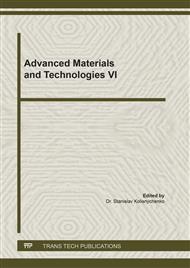[1]
Bandages and Dressings - blood, pain, infection (2019). https://www.surgeryencyclopedia.com/A-Ce/Bandages-and-Dressings.html.
Google Scholar
[2]
M. Lojpur, Dressing and bandage, M.D.&Ph.D. thesis (2016). http://neuron.mefst.hr/docs/katedre/klinicke_vjestine/Dr.%20Lojpur%20%20Dressing%20and%20bandage.pdf.
Google Scholar
[3]
A.A. Marwa, Recent Technology of Medical Textiles and Their Applications, 8th International Conference of Textile Research Division (ICTRD), National Research Centre, Dokki, Egypt, ISSN 1687-2126, (2017) 45.
Google Scholar
[4]
Ali Marwa A., Effect of textiles structural parameters on surgical healing; A case study, Autex world textile conference, Corfu, Greece IOP Conference Series: Materials Science and Engineering, 254(6), (2017).
DOI: 10.1088/1757-899x/254/6/062001
Google Scholar
[5]
J. Burch and S. Tort, How do four‐layer compression bandages compare in people, Cochrane Clinical Answers (2016), https://doi.org/10.1002/cca.738.
DOI: 10.1002/cca.738
Google Scholar
[6]
C. Moffatt, Four-layer bandaging from concept to practice Part 2: Application of the four-layer system, worldwide wounds (2005), http://www.worldwidewounds.com/2005/march/Moffatt/Four-Layer-Bandage-System-Part2.html.
DOI: 10.1177/153473460200100103
Google Scholar
[7]
Multifunctional wound dressing, Materials Modification, Inc. (2017), http://www.matmod.com/wp-content/uploads/2017/05/FenSIL.pdf.
Google Scholar
[8]
B. Mirani, E. Pagan, B. Currie, M.A. Siddiqui, R.H. Zadeh, P. Mostafalu, Y.S. Zhang, A. Ghahary and M. Akbari, An Advanced Multifunctional Hydrogel-Based Dressing for Wound Monitoring and Drug Delivery, Adv. Healthc Mater, 6(19), (2017).
DOI: 10.1002/adhm.201770103
Google Scholar
[9]
Activated carbon – Wikipedia (2019), https://en.wikipedia.org.
Google Scholar
[10]
Powdered activated carbon treatment (2018), https://en.wikipedia.org.
Google Scholar
[11]
Activated-carbon-knowledge-base (2020), https://tigg.com/resources/activated-carbon-knowledge-base/granular-activated-carbon-gac-media-selection/.
Google Scholar
[12]
K. Malik, 6 Amazing Benefits of Aloe Vera for Hair, Skin and Weight-Loss, NDTV FOOD (2019), https://food.ndtv.com/beauty/6-amazing-benefits-aloe-vera-hair-skin-weight-loss-1221869.
Google Scholar
[13]
Y. Ni and I.R. Tizard, Analytical methodology: the gel-analysis of aloe pulp and its derivatives, In: Reynolds T., Ed (2004)111–126.
Google Scholar
[14]
12 Health Benefits of Aloe Vera, FACTY HEALTH (2019), www.facty.com.
Google Scholar
[15]
J.H. Hamman, Composition and Applications of Aloe vera Leaf Gel, Molecules, 13-8 (2008) 1599–1616.
DOI: 10.3390/molecules13081599
Google Scholar
[16]
Aloe vera, Wikipedia, the free encyclopedia (2019), https://en.wikipedia.org.
Google Scholar
[17]
M. Bostenaru and C. Dumitru, Physical characteristics of geotextiles definition dimensions, 2nd international conference on geotextiles, Las Vegas, USA, (1986) 177-181.
Google Scholar
[18]
SAS. Statistics. Version 5. SAS Institute Inc. (2001), Cart, NC., USA 2.
Google Scholar
[19]
D.B. Duncan, Multiple ranges and multiple F-tests. Biometrics, 11, (1955)1-42.
Google Scholar
[20]
Standard test method for electrostatic propensity of textiles, ASTM D 4238, (2012).
Google Scholar
[21]
O.A. Hakeim, M.M. El Zawahry, N.M. Aly, N.S. El-Hawary, H.A. Diab and A.A. Marwa, Anti-Static and Functional Properties of Asminosilsesquioxane Oligomer Treated and Dyed Fabrics, Journal of The Textile Association, Jul- Aug, (2015) 90-101.
Google Scholar
[22]
G. Newcombe and M. Drikas, Adsorption of NOM onto activated carbon: Electrostatic and non-electrostatic effects, Carbon, 35(9) (1997) 1239-1250, https://doi.org/10.1016/S0008-6223(97)00078-X.
DOI: 10.1016/s0008-6223(97)00078-x
Google Scholar
[23]
D. Jaroslaw and C. Emil, Dennis D.M. and T. Konrad, Hydrophilic and super hydrophilic surfaces and materials, Soft Matter Journal, 21, (2011), https://pubs.rsc.org/en/content/articlelanding/2011/sm/c1sm05849e.
Google Scholar
[24]
R.F. Pereira, A. Carvalho and M.H. Gil, Ausenda Mendes, Paulo J. Bártolo, Influence of Aloe vera on water absorption and enzymatic in vitro degradation of alginate hydrogel films, Carbohydrate Polymer Journal 98(1) (2013) 311-320.
DOI: 10.1016/j.carbpol.2013.05.076
Google Scholar


